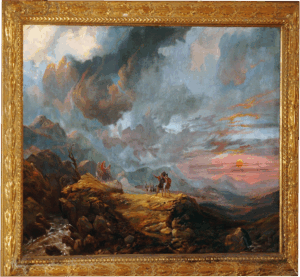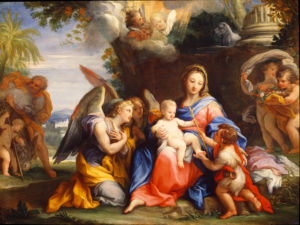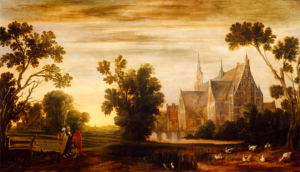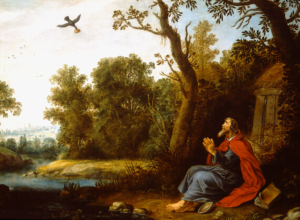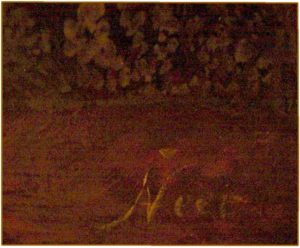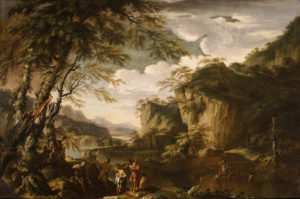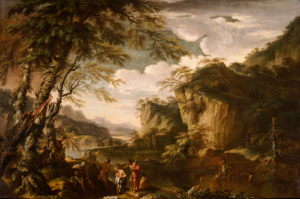Macbeth Encounters the Three Witches from Macbeth
Oil on Canvas, signed lower left
Edward Train
English, 1801-1866
During the Victorian era landscape painting became a major branch of English art, and a burgeoning preference for the genre can be seen in the Royal Academy’s mid-century exhibitions. This popularity was due in part to the wide-ranging approach of English artists to the genre. In J.M.W. Turner’s romantic imagery, John Constable’s naturalistic scenes, and William Holman Hunt’s meticulously rendered flora and fauna, Victorians perceived anew the beauty, grandeur, and stunning diversity of the natural world. Through these artists, viewers also discerned that a landscape may be far more than an appealing backdrop.
In this work inspired by Act 1, scene 3 of Shakespeare’s Macbeth, the landscape carries the storytelling power of the scene. The chiaroscuro, colors, swirling lines, and frenetic brushwork all “speak.” In a very real sense, Train’s landscape functions as a personified antagonist in his visual narrative.
Macbeth and Banquo, two victorious warriors, arrive upon a wind-swept heath “at set of sun.” There, three witches give them seemingly encouraging news: Macbeth is informed that he will not only become Thane of Cawdor but also “king hereafter.” Likewise, Banquo is told that his progeny will one day rule. Both men are initially suspicious of the hags’ prophecies—until an entourage arrives to confirm that King Duncan has indeed named Macbeth Thane of Cawdor. With this news Macbeth begins to toy with not only embracing but also hastening the witches’ prophecies.
Banquo warns his friend:
. . .Oftentimes, to win us to our harm,
The instruments of darkness tell us truths,
Win us with honest trifles, to betray ’s
In deepest consequence.
Act 1, scene 3, ll. 124-128
However, the “fair tidings” have already set alight Macbeth’s ambition, kindling the “horrible imaginings” that foreshadow his descent into psychological and spiritual darkness. Before days end, Macbeth (goaded by his equally ambitious wife) will murder the rightful king.
Notice how Train uses atmospheric perspective to create a foreboding sky. His loose brushwork and subtle color blending create an illusion that the lowering storm clouds hovering over the witches are fast moving toward the blood red sun. Soon, what remains of the light will be “put out,” leaving the characters in darkness. The jagged terrain further accentuates Macbeth’s and Banquo’s precarious position. The implied diagonal line connecting these warriors to the witches further heightens the suspense. Notice that the witches on the left look down on Macbeth and Banquo who are “center stage.” This slightly elevated positioning insinuates their psychic dominance. In addition, the shadowy entourage approaching in the distance foreshadows that the witches’ first prophecy will soon be fulfilled, setting in motion the “horrible imaginings” spawned by Macbeth’s musings.
Although scholars continue to debate whether Shakespeare was a Christian, most agree that the “worlds” he creates reflect a clear understanding of the moral law and the human condition. In Shakespeare’s dramas a disregard for the divine order results not only in human suffering (turbulence among men) but also in upheaval in the natural world (tempestuousness in nature). It is not by chance, therefore, that Macbeth’s temptation takes place upon a storm-tossed heath. Nor is it surprising that following the murder of King Duncan raging storms spread across the land, daylight is entombed in darkness, and Duncan’s “beauteous and swift horses have turned wild, broken their stalls, and devoured one another.”
Shakespearean scholar David Bevington says that “Macbeth is in some ways Shakespeare’s most unsettling tragedy, because it invites the intense examination of the heart of a man who is well-intentioned in most ways but who discovers that he cannot resist the temptation to achieve power at any cost.”
One final intriguing detail is the existence of a similar work by Train titled Landscape with Three Mythological Women Stopping the Roman’s Army’s Advance. This work is dated in 1865 a year before the artist’s death. Although the painting has the same setting as M&G’s Macbeth, it is from a different vantage point. Perhaps Train was exploring how vantage point might alter mood. In any case, the 1865 landscape is less poignant and evocative in its narrative power.
Donnalynn Hess, Director of Education and Bella Vita Sanders, Research Intern
Bibliography
The Complete Works of Shakespeare, David Bevington
Victorian Painting, Christopher Wood
Published in 2025
